Somebody asked the question whether animal shelters can refuse animals. The answer must depend on the type of animal shelter we are referring to.
There are a wide range of animal shelters. Two types are the no-kill rescue animal shelter and the traditional, open admission shelter.

Open admission
The open admission shelter should not refuse an animal. However, historically the number of unwanted animals is larger than the amount of available space in America’s animal shelters.
Because of that inbalance, open admission shelters receive too many requests to take in animals. They don’t have the space to house them. Therefore they have to euthanise some to make room. The ones they euthanise are the least likely to be adopted, the sick and those with behavioral problems. The selection process is open to abuses and distortions. For intance how do you assess behavioural issues at a shelte where the cats are stressed?

No-kill
The no-kill animal shelter is a growing trend as far as I can tell. This is because a lot of people don’t like the idea of killing animals at shelters. It undermines the whole purpose of the shelter. It makes a mockery of the word “shelter”.
But no-kill shelters must limit the number of animals that they take because they would run out of space if they didn’t. There has to be some way of limiting numbers either kill or ban entry. Are they selective in the animals that they take? The answer is probably yes. I guess they select the least adoptable animals. All the ones that are sick and so on. They have to prioritise. They have no other choice as long as there are more unwanted animals than there are spaces at shelters. The ones they can’t take probably end up at the open admission shelters where they might be euthanised.
There is some leeway in this system. No-kill does not mean a 100 percent save rate. Some animals are killed. They save rate is 90 percent as I recall.

Selection processes
It occurs to me that both the no-kill shelters and the open admission shelters select cats on a similar basis but in the former they are not taken in and in the latter they are euthanised. Is that a fair comment? Do I have this wrong?

Wider issues
The wider issues are important. Animal rescue shelters are in the business of reacting to an overpopulation of animals. It’s a reactive process.
They mop up the mess. The key is to stop the mess being created. The preferred method would be to stop cats and dogs breeding informally creating unwanted animals. Many local authorities in the USA are wrestling with the means to achieve this goal. It is very difficult because laws dictating how people should look after their cats and dogs are hard to enforce. And, also, people do not like the interference of local authorities on these matters. They like their freedoms.

The hidden deaths
A lot of people do not feel the pain and distress caused by the euthanasia of millions of companion animals and animal shelters across America or indeed any other country. I chose America because that is the biggest market for companion animals. It’s the most interesting and the most discussed.
Because the wider public don’t sense the immorality and difficulties of euthanising millions of animals it goes on unabated. There has been some progress to be fair. The kill rate at animal shelters in America has dropped remarkably over the years. There is work to do. Many healthy animals who would make great companions are killed in the back rooms of shelters.
I would like an animal rescue expert to comment on this post. It needs an expert touch.

